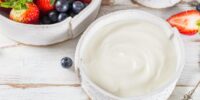What's the latest in prebiotic research? October edition
This monthly feature provides an overview of some of the latest studies on prebiotics. We’ll share key findings and insights from the studies. Have a study you’d like us to cover? Email GPA Communications Director Traci Kantowski traci@prebioticassociation.org.
An Updated Review on Prebiotics: Insights on Potentials of Food Seeds Waste as Source of Potential Prebiotics
This review discusses the potential use of seed wastes in prebiotic production, consequently reducing the environmental hazards posed by these wastes. The authors discuss that a great deal of solid waste, which comes from leaves, spoiled fruits, pulp, unused peels, fibrous materials, and inedible parts of fruits, which comprise the stones, husks, kernels, and seeds are generated from fruit processing. This waste becomes an environmental hazard due to deposition in rivers and landfills. Some processors recycle these wastes as feed additives for livestock. Asparagus, chicory, garlic, onions, honey, wheat, soybeans, peas, beans, bananas, artichokes, tomatoes, and other plant materials are naturally occurring food items that are rich in prebiotics. These naturally occurring foods are also seed-producing. The review goes into great detail regarding the benefits of prebiotics and why upcycling makes sense from a health and environmental perspective for a variety of seeds. They encourage research to expand the use of seed waste.
Key takeaways.
- Increased consumption of fruits and vegetables have led to an increase in seeds waste
- The seeds provide a viable source of prebiotics that could be added to animal feed and human food to enhance prebiotic consumption
- This approach would address the environmental impact of increased seed waste and would provide a healthy source of prebiotics for humans and animals
Access the study: https://pubmed.ncbi.nlm.nih.gov/36013128/
Reference Bamigbade GB, Subhash AJ, Kamal-Eldin A, Nyström L, Ayyash M. An Updated Review on Prebiotics: Insights on Potentials of Food Seeds Waste as Source of Potential Prebiotics. Molecules. 2022 Sep 13;27(18):5947. doi: 10.3390/molecules27185947. PMID: 36144679; PMCID: PMC9505924.
Perspective: Leveraging the Gut Microbiota to Predict Personalized Responses to Dietary, Prebiotic, and Probiotic Interventions
This review discusses the major computational and experimental tools being applied to microbiota-mediated personalized nutrition and health. The latest advances in in silico modeling of the microbiota-nutrition-health axis, including the application of statistical, mechanistic, and hybrid artificial intelligence models are discussed. Additionally, they describe high-throughput in vitro techniques for assessing interindividual heterogeneity, from ex vivo batch culturing of stool and continuous culturing in anaerobic bioreactors, to more sophisticated organ-on-a-chip models that integrate both host and microbial compartments. They give an overview of in vivo approaches for a better understanding of personalized, microbiota-mediated responses to diet, prebiotics, and probiotics, from nonhuman animal models and human observational studies, as well as human feeding trials and crossover interventions. They highlight examples of existing, consumer-facing precision nutrition platforms that are currently leveraging the gut microbiota. They give a vision of a precision nutrition and healthcare future, which leverages the gut microbiota to design effective, individual-specific interventions.
Key takeaways:
- The authors declare that “Growing evidence supports a vision of personalized, participatory nutrition and healthcare that is achievable in the near term.”
- They discuss the need to evaluate each technique individually rather than try to develop a one size fits all algorithm for the microbiome
- They caution that we need a rigorous set of standards for best practices in designing and assessing the efficacy of personalized interventions
Access the study https://pubmed.ncbi.nlm.nih.gov/35776947/
Reference Gibbons SM, Gurry T, Lampe JW, Chakrabarti A, Dam V, Everard A, Goas A, Gross G, Kleerebezem M, Lane J, Maukonen J, Penna ALB, Pot B, Valdes AM, Walton G, Weiss A, Zanzer YC, Venlet NV, Miani M. Perspective: Leveraging the Gut Microbiota to Predict Personalized Responses to Dietary, Prebiotic, and Probiotic Interventions. Adv Nutr. 2022 Oct 2;13(5):1450-1461. doi: 10.1093/advances/nmac075. PMID: 35776947.
Biological activity of galacto-oligosaccharides: A review
This review summarizes the sources, classification, preparation methods, and biological activities of Galacto-oligosaccharides (GOS), focusing on the introduction and summary of the effects of GOS on ulcerative colitis (UC), to gain a comprehensive understanding of the application of GOS.
Key takeaway:
- GOS is marketed as a mixture of galactosyl oligosaccharides with different degrees of polymerization and configurations.
- This review gives a thorough overview of the function of GOS as well as mechanism of action they use UC to do this
- Most studies on prebiotic utilization have been conducted in vitro, but the growth effects in these experiments are not necessarily replicated in the gut.
- Human studies on the effects of prebiotics (GOS), especially on infant growth and nutritional development, are a new direction for future research.
- Due to the key role of GOS in the functional food field, screening for β-galactosidase with transgalactosylation is a suggested research direction
Access the study: https://www.ncbi.nlm.nih.gov/pmc/articles/PMC9485631/
Reference Mei Z, Yuan J, Li D. Biological activity of galacto-oligosaccharides: A review. Front Microbiol. 2022 Sep 6;13:993052. doi: 10.3389/fmicb.2022.993052. PMID: 36147858; PMCID: PMC9485631.
This list was curated by Susan Hewlings, Ph.D., R.D., Director of Scientific Affairs Nutrasource/GRAS Associates



